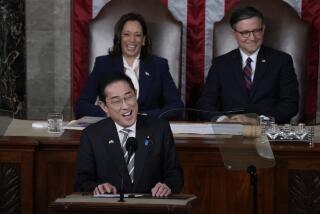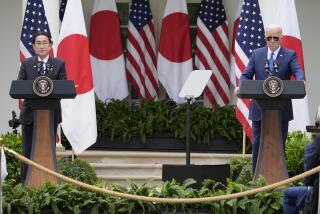Security Pact Expected to Alter Way Japan Sees Its Military Role
- Share via
TOKYO — The joint security declaration signed Wednesday by President Clinton and Japanese Prime Minister Ryutaro Hashimoto represents the start of a sea change in the way Japan views its own military role, analysts here say.
Although pundits who declare Japan to be at historic crossroads often turn out to be wrong, everyone from liberal commentator Minoru Morita to former defense official Narihiko Ueda agree that the declaration has effectively pushed the nation beyond its insular mentality to publicly proclaim a responsibility for Asia’s peace through a powerful military partnership with the United States.
Until now, the U.S.-Japan security treaty has overwhelmingly been viewed here mainly as a device for Japan’s defense. But that raison d’etre became less credible after the collapse of Japan’s biggest Cold War nemesis, the old Soviet Union--and because fewer Americans are willing to perpetually support the treaty as a means of defending the world’s second-biggest economy.
“The concept that the security treaty is no longer a Japan protection device, but is for regional security like [the North Atlantic Treaty Organization], is a turning point,” said Robert Orr, a senior research fellow at Temple University here. “The extent to which that concept is embraced means the survival of the treaty. If it can’t be embraced, the treaty will die because Americans won’t support it.”
Both elements have always been part of the 1951 treaty, under which the United States is obliged to defend Japan in exchange for use of the bases and the more than $5 billion now annually provided by Tokyo to support the 47,000 American troops here. But analysts say the declaration has clearly signified a reversal of those priorities--one that involves a new, expanded role for Japan in helping police the Asia region in concert with the United States.
The declaration has been backed up in recent days by new agreements for Japan to begin supplying such services as transport, refueling and the replacement of weapons parts and to review 1978 guidelines on Japanese cooperation during military crises. In addition, the two sides agreed to enhance technology exchange, including joint research on the F-2 support fighter and current study of a ballistic missile defense.
Clinton and Hashimoto, each facing an election, appear to have conveyed images here of being strong leaders--although that created as much concern as elation in Japan. Hashimoto, the onetime snarly trade minister, turned his fabled locution skills into a tool for statesmanship by clearly enunciating on national TV what few prime ministers have before: that it is time for Japan to clearly determine what it can do to cooperate with the United States in times of crisis.
“I expect there are things we can do within our present legal system, and it’s our responsibility to properly research this point,” Hashimoto declared at a joint news conference with Clinton. He also challenged opponents of the security treaty: “Would it be possible for Japan alone to defend itself? To do that, a major effort would be needed.”
His unequivocal stand broke decades of fudging on what has long been a taboo subject here, just as it modified his image as a nationalistic trade hawk toward that of global thinker.
Some were pleased. “Our prime minister really has some intention to lead us,” said Tamotsu Asami, a security specialist with the Yomiuri Research Institute.
Asami and others credited Hashimoto’s leadership, including a personal appeal to Clinton at a February meeting in Santa Monica, with achieving a U.S. pledge to return the highly symbolic Futenma Marine Corps Air Station to local Okinawan landowners within seven years. While some skeptics view the pledge as a shell game that simply shifts the problem to other parts of Okinawa and Japan, Ueda, the former defense official, said Hashimoto cracked through the bureaucratic inertia on both sides.
Commentator Morita agreed that the security declaration represented a “big change” for Japan--but the wrong kind. He said Hashimoto’s desire for flashy leadership had ended up jeopardizing the nation’s security by expanding its military role too far and threatening ties with China.
“Right now, the overwhelming opinion in Japan’s political world is that Hashimoto did well, but as time goes on people will begin to understand that this was a big mistake,” Morita said.
Others, including the influential Asahi and Mainichi media organizations, have expressed fears that Japan has suddenly been snared into America’s global military strategy with virtually no public debate and the possibility of involvement in actual combat, a role currently barred here.
But some here praised Clinton for not pushing Japan to revise its pacifist constitution; U.S. officials have repeatedly said they would carry out the expanded cooperation within the bounds of current Japanese law. Ueda said Clinton’s appeal to the Japanese people to help lead alongside the United States had surprised and pleased them and would compel them to think more seriously about their responsibilities.
And Gerald Curtis, a Columbia University political science professor, said Clinton had pulled off a diplomatic coup by finessing the recently announced Okinawa base reductions without giving Asia the impression of retreat, while coaxing Japan into a greater role.
“He has tied Japanese defense policy even closer to the U.S. and succeeded in getting the Japanese government to be open to the public about what the purpose of this treaty is,” Curtis said. “It’s a great success.”
Japanese officials say three events converged to give them the confidence to plunge forward with a more active policy direction. First, the Socialist Party dropped its longtime opposition to U.S.-Japanese military cooperation after joining the ruling coalition in 1994 and, facing annihilation at the polls, became “more realistic” about the need to expand support.
Second, the involvement of three U.S. servicemen in the savage rape of an Okinawa schoolgirl pushed the nation to begin thinking about its security--and whether the American bases were necessary--for the first time in decades.
Finally, China’s missile tests in the Taiwan Strait helped people realize they were still surrounded by potential threats.
“This is a watershed,” said Joseph Cronin, the National Defense University professor whose research laid the groundwork for the famous “Nye Initiative” affirming troop levels at 100,000 in Asia. “. . . It finally does put the relationship on a post-Cold War footing . . . to build a partnership that will help the future.”
Megumi Shimizu of The Times’ Tokyo Bureau contributed to this report.
(BEGIN TEXT OF INFOBOX / INFOGRAPHIC)
Japan’s Defense Capabilities
Defense budget*:
$53.8 billion
Constitutes 0.959% of
gross national product
Total armed forces:
239,500
Ground forces:
Main battle tanks: 1,160
Artillery: 1,411
Maritime forces
Self-defense vessels: 161
Naval aircraft: about 170
Air forces
Combat aircraft: about 300
* Fiscal year 1995
Source: The Defense Handbook, 1996; The Military Balance 1995/6.
More to Read
Sign up for Essential California
The most important California stories and recommendations in your inbox every morning.
You may occasionally receive promotional content from the Los Angeles Times.














